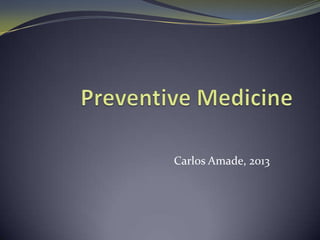Preventive medicine
•Download as PPTX, PDF•
39 likes•20,018 views
what is a preventive medicine. this lecture gives you an accurate information about preventive measures
Report
Share
Report
Share

Recommended
Recommended
More Related Content
What's hot
What's hot (20)
Socio Cultural Factors Related to Health and Disease 

Socio Cultural Factors Related to Health and Disease
Similar to Preventive medicine
Similar to Preventive medicine (20)
Epidemiological Approach to Disease and Intervention

Epidemiological Approach to Disease and Intervention
Population medicine and changing concepts of disease

Population medicine and changing concepts of disease
Recently uploaded
Recently uploaded (20)
Seal of Good Local Governance (SGLG) 2024Final.pptx

Seal of Good Local Governance (SGLG) 2024Final.pptx
Food Chain and Food Web (Ecosystem) EVS, B. Pharmacy 1st Year, Sem-II

Food Chain and Food Web (Ecosystem) EVS, B. Pharmacy 1st Year, Sem-II
ICT role in 21st century education and it's challenges.

ICT role in 21st century education and it's challenges.
On National Teacher Day, meet the 2024-25 Kenan Fellows

On National Teacher Day, meet the 2024-25 Kenan Fellows
General Principles of Intellectual Property: Concepts of Intellectual Proper...

General Principles of Intellectual Property: Concepts of Intellectual Proper...
This PowerPoint helps students to consider the concept of infinity.

This PowerPoint helps students to consider the concept of infinity.
Micro-Scholarship, What it is, How can it help me.pdf

Micro-Scholarship, What it is, How can it help me.pdf
Asian American Pacific Islander Month DDSD 2024.pptx

Asian American Pacific Islander Month DDSD 2024.pptx
Ecological Succession. ( ECOSYSTEM, B. Pharmacy, 1st Year, Sem-II, Environmen...

Ecological Succession. ( ECOSYSTEM, B. Pharmacy, 1st Year, Sem-II, Environmen...
Preventive medicine
- 2. Epidemiology “the study of the distribution and determinants of health-related states or events in specified populations, and the application of this study to the prevention and control of health problems” (BONITA 2006)
- 3. Prevention of disease The outcome of any investigation on risk is to determine what can be done to reduce health risks within populations
- 4. Prevention of disease • The decline in death rates that occurred during the 19th century in high-income countries was principally due to a decrease in deaths from infectious disease. Most of the decline in mortality took place before specific disease prevention interventions and has been attributed to improvements in nutrition, housing, sanitation and other environmental health
- 5. Prevention of disease In the 20th century, the declines in death rates from cardiovascular disease have accelerated in high- income countries. These gains have been the result of a wide range of measures directed at both whole populations and
- 6. Preventive potential Major causes of disease are preventable.
- 7. Social determinants of health Conditions in which people live and work. Addressing the social determinants of health is the fairest way to improve health for all people. Good medical care is vital, but the factors that can undermine people’s health – such as social position, housing conditions and occupational risks – need to be addressed
- 8. Who should practice preventive Medicine? Public health nurses, medical sociologists, psychologists, health economists, sanitary engineers, pollution control experts and occupational hygienists are all involved in disease-prevention efforts. All people!!!!!!!!!
- 9. Levels of prevention Four levels Each level targets conditions which have an established role in causing disease. Approaches to prevention overlap and merge Primordial and primary prevention contribute most to the health of the whole population Secondary and tertiary prevention are generally focused on people who already have signs of disease
- 11. Primordial prevention Avoid the emergence and establishment of the social, economic and cultural patterns of living that are known to contribute to an elevated risk of disease.
- 14. Primary prevention To limit the incidence of disease by controlling specific causes and risk factors at: The whole population with the aim of reducing average risk (the population or “mass” strategy) People at high risk as a result of particular
- 17. Secondary prevention To reduce the more serious consequences of disease through early diagnosis and treatment Between the onset of disease and the normal time of diagnosis
- 19. Requirements for secondary prevention The two main requirements for a useful secondary prevention programme are: Safe and accurate method of detecting the disease Effective methods of intervention.
- 20. Screening The process of using tests on a large scale to identify the presence of disease in apparently healthy people.
- 21. Types of screening Mass screening = for the whole population (or subset) Multiple or multiphasic screening uses several screening tests at the same time Targeted screening of groups with specific exposures Case-finding or opportunistic screening = at
- 23. Screening tests: match the columns d/(c+d) a/(a+c) a/(a+b) d/(b+d)
- 24. Length Bias
- 25. Tertiary prevention To reduce the progress or complications of established disease Important aspect of therapeutic and rehabilitation medicine. Consists of the measures intended to reduce impairments and disabilities, minimize suffering caused by poor health
- 27. Thank you
